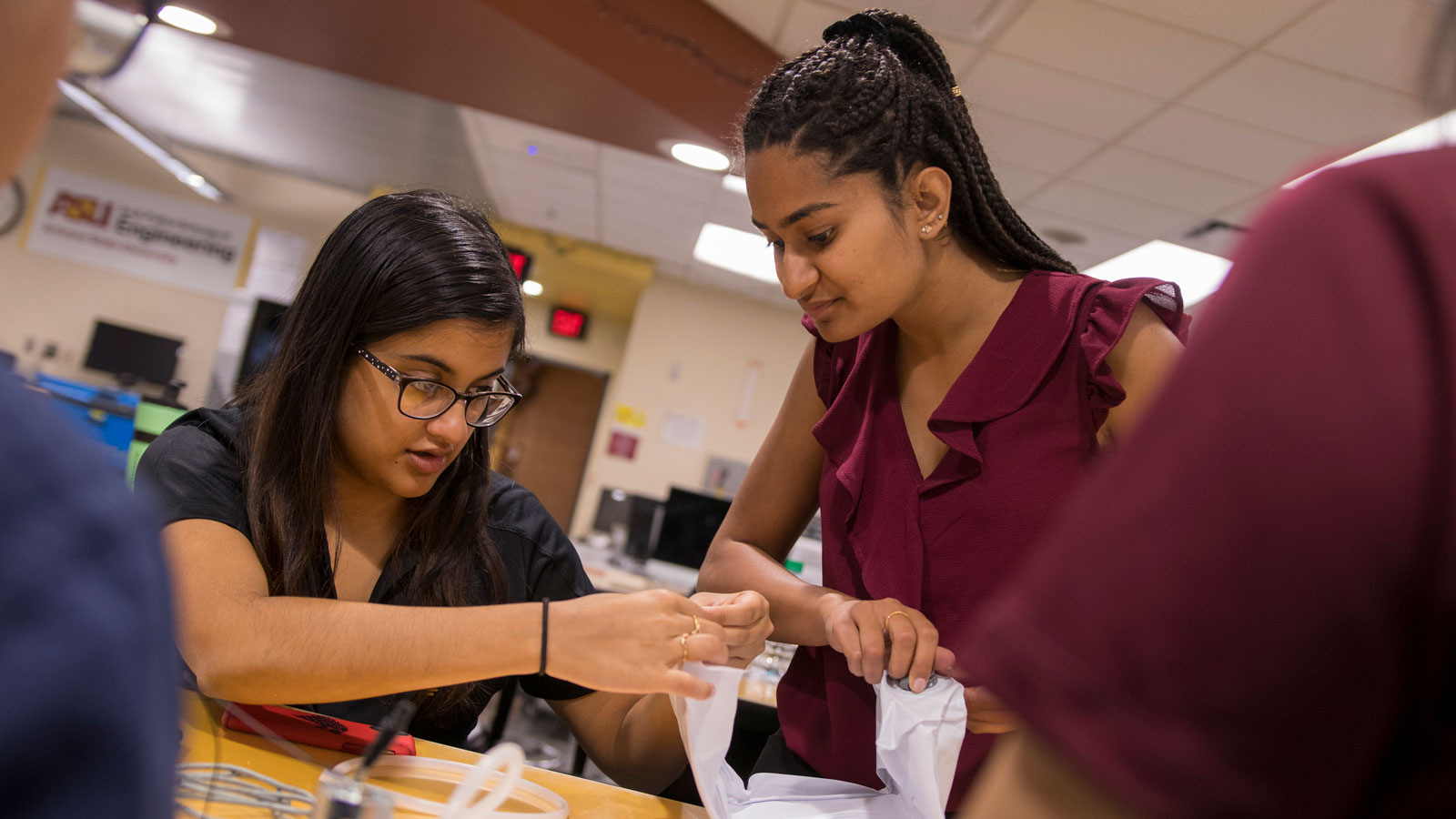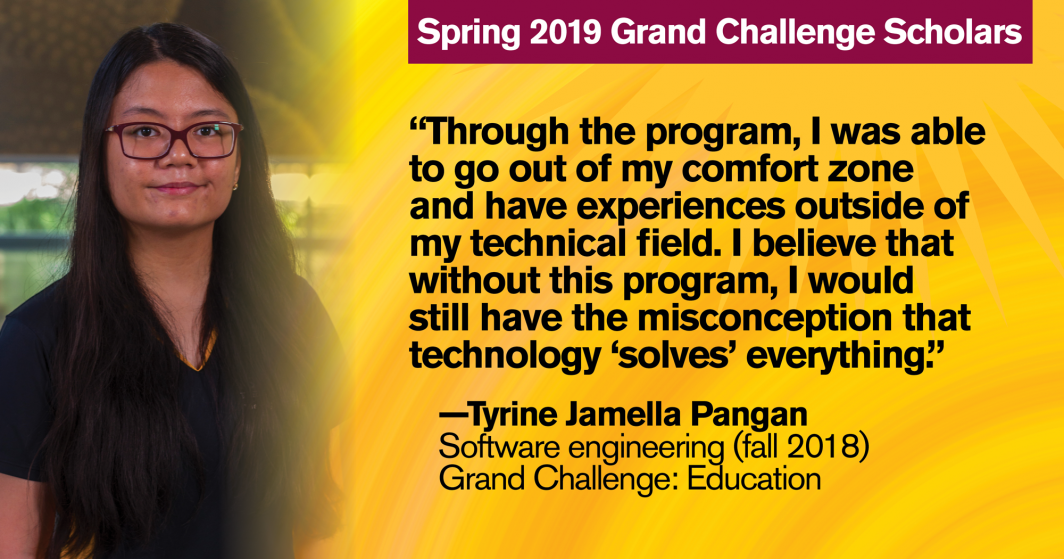13 ASU students earn prestigious NAE Grand Challenge Scholar title

Thirteen students from the Ira A. Fulton Schools of Engineering graduated as National Academy of Engineering Grand Challenge Scholars, having completed coursework and experiential opportunities in service learning, multicultural awareness, entrepreneurship, developing an interdisciplinary perspective and conducting research or a creative project related to one of 14 Grand Challenges designated by the NAE. Pictured from top left to bottom right: Philip Mulford, Stephen Lane, Randee Huffman, Ekta Patel, Cole Brauer, Andrea Kraetz, Eduardo Luciano Huapaya, Jobana Westbay, Diana Chen, Sheena Benson and Bhavna Ramesh. Not pictured: Tyrine Jamella Pangan and Ryan McBurney. Photo by Erika Gronek/ASU
Engineers solve some of the world’s biggest problems, but they need more than technical skills to create meaningful solutions.
Ambitious students in the Ira A. Fulton Schools of Engineering at Arizona State University take on more than their engineering degree requirements when they participate in the Grand Challenge Scholars Program. Through GCSP, they become transdisciplinary, collaborative and global problem-solvers.
Endorsed by the National Academy of Engineering, the program tasks students with choosing one of the NAE's 14 Grand Challenges facing society over the next century that span the broader themes of sustainability, health, security and joy of living.
Students accepted into the program must complete coursework and experiential opportunities for five components of the program: service learning, multicultural awareness, entrepreneurship, developing an interdisciplinary perspective and conducting research or a creative project related to their Grand Challenge theme.
During the 2018-19 academic year, 13 Fulton Schools students were added to the official NAE Grand Challenge Scholars Registry as they completed the program requirements and graduated with their bachelor’s degrees. This is the second-largest graduating class of Grand Challenge Scholars from ASU after the graduating class of spring 2017. They join 43 others who have completed the program since its inception at ASU in 2011.
“Through their own individual set of experiences, each of these students has explored different cultures, applied their technical skills to research or creative projects, developed an entrepreneurial mindset, learned to view problems from an interdisciplinary perspective and has already made an impact on local and global communities through service learning projects,” said Amy Trowbridge, director of the ASU Grand Challenge Scholars Program and a senior lecturer in the Fulton Schools. “These students are dedicated to creating value for communities in the world, and I can’t wait to see the positive impact they have in the future.”
The program often attracts often Fulton Schools’ most high-achieving students who take part in ambitious programs that offer well-rounded experiences. A majority of the program's students are in Barrett, The Honors College, others are Entrepreneurship and Innovation Fellows and many take on minors in other subjects in addition to their engineering studies. The program also opens up opportunities for students that are often in the realm of graduate studies. This year, at least two students co-authored research journal articles, four or more presented their work at national conferences and a few even started their own businesses.
The Grand Challenge Scholars Program encourages many students to think outside their majors as well as explore new ways their skills can be applied to developing solutions to the Grand Challenges.
Recent aerospace engineering graduate Ryan McBurney explored how to increase the efficiency of solar energy conversion for the research part of his program requirements.
“It’s a little strange that an aerospace engineering major decided to do this kind of work instead of fluid mechanics of structural stuff,” McBurney said. “But I like to change it up and learn different things.”
McBurney initially sought to complete the Grand Challenge Scholars Program requirements on the Grand Challenge theme of security to prepare for a future career in national defense. But after reaching out to Liping Wang, an associate professor of aerospace and mechanical engineering, he became involved in an energy and heat transfer project as part of the Fulton Undergraduate Research Initiative.
After graduation, McBurney is starting his career with the Naval Air System Command, a department of the U.S. Navy, as an aerospace engineer in the aeromechanics and thermal analysis branch.
“I get to be in a field that my undergraduate major covered and also relates to all the things I’ve been doing outside the classroom in thermal analysis and heat transfer,” he said. “By participating in GCSP, I got involved with extracurricular programs and classes outside of the typically structured aerospace engineering academic program. I also took classes in national security and defense and a lot of other related courses which looked nice on my transcripts when applying to Department of Defense jobs.”

Aerospace engineering student Ryan McBurney presents research at the spring 2019 Fulton Undergraduate Research Initiative symposium exploring the use of metal films to increase the efficiency of solar energy conversion beyond the current limits of commercial solar panels. As an aerospace engineering major, McBurney’s research was a cross-disciplinary application of his skills. Photo by Erika Gronek/ASU
The impact Grand Challenge Scholars Program students make extends well beyond U.S. borders, especially because developing innovators and leaders for the global economy is a central goal of the program's multicultural awareness component.
Through the program, McBurney got involved with Engineering Projects In Community Service, or EPICS, for his service learning requirement. He applied his energy focus to create a solar-powered refrigerator for a professor at an agricultural university in Nigeria. The refrigerator, which stores enzymes for biofuel research, was delivered to Nigeria as McBurney wrapped up his undergraduate studies in April.
“More than half of these students worked to develop solutions to fulfill the needs of local or global communities through our EPICS program for a combined total of 16 semesters,” Trowbridge said. “And that doesn’t include the time that this group has impacted the community in other ways through developing educational activities and events, providing mentorship and leading tours and school visits, to inspire future generations of engineers.”
Andrea Kraetz, a recent honors student and chemical engineering graduate who completed her degree and Grand Challenge Scholars Program requirements in three years, took on the Grand Challenge of clean water access. She developed a selective adsorbent templating process to remove harmful selenium from water, thereby providing cleaner water and combating water scarcity by making clean water more accessible.
“We can see there is a 95% removal of selenium with the templating process versus the nontemplated material that absorbs around 40% of the selenium,” Kraetz explained. “It’s all about clean water and healthier water.”
Beyond applying her chemical engineering skills to solving a Grand Challenge, she appreciated the broader education the program provides to students.
“For engineering majors, it is usually just about the STEM subjects, like thermodynamics or math,” Kraetz said. “But with GCSP they try to bring in other elements, like social factors, with courses that can help provide a broader purpose to engineering projects.”
Kraetz will go on to pursue a doctoral degree in chemical engineering at Johns Hopkins University as a National Science Foundation Graduate Research Fellow, taking on new challenges in sustainable energy research.

At the spring 2019 FURI symposium, chemical engineering student Andrea Kraetz presents sustainability research into selective adsorbents to remove selenium from water to make water treatment more efficient. Her research was sponsored by W. L. Gore & Associates. Photo by Marco-Alexis Chaira/ASU
Though the program adds extra work on top of an already packed engineering curriculum, students view it as an experience that helps them to stand out.
“GCSP has given me a lot of opportunities that I never would have imagined having otherwise because the different components really forced me or encouraged me to expand my horizons,” said Bhavna Ramesh, a biomedical engineering graduate and honors student who tackled two health-related Grand Challenges: advancing health informatics and engineering better medicines.
Ramesh studied abroad in Australia and Fiji for three weeks during her sophomore year to explore global health and sustainability as her multicultural component. She is one of five members of the 2018-19 Grand Challenge Scholars Program class who studied abroad. Between them, they studied in nine different countries. For the service learning requirement, Ramesh mentored younger engineering students as part of Engineering Futures.
The program also encouraged her to get involved in entrepreneurship through an internship as a market researcher at a wearable sensor technology startup.
Ramesh is also looking into commercialization aspects for her Grand Challenge Scholars Program research project, which she presented as part of the FURI symposium in spring 2019. She collaborated with a team to develop a pressure ulcer risk assessment device for patients confined to hospital beds. When areas of a patient’s body that don’t have much fat between bone and skin make contact with the hospital bed, the skin can break and cause pressure ulcers, which are painful and can often cause irreversible damage.
Ramesh and her team are working with their clinical mentors at Phoenix Children’s Hospital to obtain a patent on their device.
In completing the project, which also served as her biomedical engineering capstone project, Ramesh stepped well outside the biomedical engineering curriculum to take on an interdisciplinary research approach that involved studying and using machine learning techniques to develop an algorithm to classify individual patients as likely or unlikely to develop pressure ulcers.
Together, the five program requirements made for a rewarding challenge.
“GCSP has definitely made me into a more well-rounded scholar,” Ramesh said. “I have a lot of diverse experiences, I’m more aware of cultural differences whether it is in the health industry or just generally, and I think that will translate really well into being mindful of my research and what other people are pursuing.”
This experience will come in handy as Ramesh begins studies for a biomedical engineering master’s degree at the University of California, Los Angeles in the fall. She hopes to one day pursue a research career in the mental health care field.

Biomedical engineering students Bhavna Ramesh (left) and Ekta Patel (right) work on their Grand Challenge Scholars Program research component. They worked as part of a team to create a device to assess the risk of developing pressure ulcers for patients in hospital beds. Photo by Marco-Alexis Chaira/ASU
Ekta Patel, a fellow recent biomedical engineering graduate and honors student, partnered with Ramesh on the pressure ulcer device project. She took on the triple challenge of pursuing an engineering degree, participating in the Grand Challenge Scholars Program and taking on the pre-medical student track, each of which present their own program requirements, challenges and demands on her time.
Patel says pre-med students can be hesitant about also choosing an engineering major, but she was determined to do both. The program provided her a framework to complete each set of requirements — and get additional valuable opportunities.
“GCSP kept me grounded in engineering, and I was also able to do all my pre-med stuff,” Patel said. “All the experiences I had doing research and entrepreneurship just made me a better student overall. I have a lot more skills added on, and I think I’m better prepared to ultimately apply to medical school.”
The opportunities students are able to take advantage of because of the program requirements can make the challenges of such a strenuous program into an unforgettable journey.
“GCSP has been so awesome,” Patel said. “I’ve loved every second.”
More Science and technology

Hack like you 'meme' it
What do pepperoni pizza, cat memes and an online dojo have in common?It turns out, these are all essential elements of a great…

ASU professor breeds new tomato variety, the 'Desert Dew'
In an era defined by climate volatility and resource scarcity, researchers are developing crops that can survive — and thrive —…

Science meets play: ASU researcher makes developmental science hands-on for families
On a Friday morning at the Edna Vihel Arts Center in Tempe, toddlers dip paint brushes into bright colors, decorating paper…














